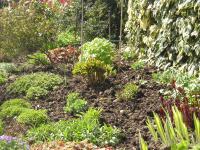From Bin to Border
 Homemade garden compost can do wonders for your soil
Homemade garden compost can do wonders for your soilNow is a good time to be digging in home made garden compost around the garden.
Making your own garden compost has to be one of the most rewarding jobs to do in the garden. Itís hard work, but so much more satisfying than visiting the garden centre to buy a box of chemical fertilizer.
This time of year is perfect for getting the compost on to the borders. There is usually space to work on at this time of year before the lush growth later in the gardening year dominates and makes distribution of the compost more difficult.
The whole range of plants can have home made garden compost lightly forked in around their base. Trees, shrubs, climbers, herbaceous perennials and bulbs will benefit from the organic tonic at this time of year. One exception is the Iris group that produces soil level rhizomes; these rhizomes need to be baked by the summer sun to produce a good flowering performance. These Irises wonít appreciate their rhizomes being covered in compost.
Garden compost can be described as an organic fertilizer because it is derived from living material. The term organic and conditions of itís use are slightly relaxed when it comes to compost; although a garden compost is classified as organic it may well be the product of decaying, conventionally grown plant matter.
Most homemade garden composts tend to be balanced, having relatively equal amounts of the vital nutrients; Nitrogen, Phosphorus and Potassium. If anything, they are slightly higher in Potassium, making them ideal for the promotion of good flower and fruit production.
Water is a transporting system for plant nutrients, and by adding garden compost to the soil you not only add food, you also increase the soilís ability to hold on to any precipitation therefore helping with the uptake of nutrients through the roots.
It has to be said that when it comes to quantity, you do have to use a lot more organic fertilizer such as homemade compost in comparison to the more concentrated chemical alternatives. But using more product to get the same amount of essential nutrients into the soil is not such a bad thing. Adding copious amounts of bulky organic matter to the soil will greatly improve a soilís structure especially on sandy and heavy clay soils. Such soil conditions will encourage strong, healthy root growth, therefore increasing the uptake of available nutrients.
The decayed plant material in the compost technically known as humus has a really positive effect on drainage and aeration (ability to allow more air into the soil). Make sure the compost is well rotted before you use it, it should be dark in colour, you should not be able to recognise that it has been produced from decayed plant material; it should be nice and crumbly in texture.
The basic rules regarding what should go in the compost heap include no meat or other sources of protein as these will attract vermin. From personal experience, I donít think egg shells rot at all in the bin, I put spent cut flowers in, tea bags and I am currently trialling how the contents of my paper shredder rot in the compost. Grass cuttings should be mixed with other, more coarse materials because air cannot penetrate large clumps of grass cuttings, greatly slowing down the composting process.
Using home-made compost does not cost anything apart from your time and dedication. Later in the year you will reap the rewards of your hard work.
Filed under DIY Gardening Jobs.
